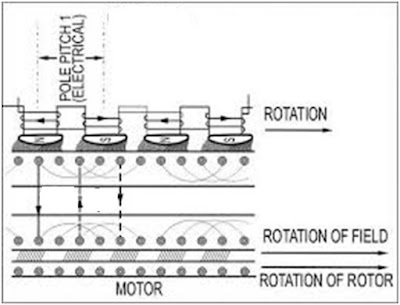The working principle of Three phase Induction Motor is basically based on the principle of mutual induction as in case of transformer. The major difference between them is that transformer is static in nature i.e. it doesn’t have any moving parts whereas Induction Motor is a dynamic one. Another difference between a Transformer and an Induction Motor is that Transformer has concentrated winding whereas Induction Motor has distributed winding.
Working Principle:
- Three phase AC supply given to Induction Motor produces a constant amplitude Rotating Magnetic Field which rotates at synchronous speed with respect to stator.
- This rotating field cuts the rotor conductors which are stationary initially and induces an emf as per Faraday’s law of electromagnetic induction.
- Emf drives current in rotor conductors as they are short circuited by end rings.
- So now we see that current carrying conductors of rotor are placed in a magnetic field, hence force acts on each of these conductors as per F = idlxB where F is the force on a conductor carrying current I and length dl.
- The resultant of forces on all the conductors produces a rotating effect on the rotor i.e. torque.
Now the question arises is “In which direction does the rotor rotate?” This can be easily answered if from Lenz’s law. As per Lenz’s Law “effect opposes the cause”.
- In Induction Motor, cause is ‘rotating magnetic field cutting rotor conductors or the flux cutting action’ & end effect is the ‘torque’.
- So, for effect i.e. torques to oppose the cause i.e. flux cutting action, torque produced makes the rotor rotate in the same direction as that of the RMF. Thus the relative velocity between the rotor and rotating magnetic field becomes (Ns – Nr) where Ns = Synchronous speed of rotating magnetic field and Nr = Speed of rotor.
Now the point is, can the speed of Rotor become equal to the synchronous speed?
The speed of Rotor cannot be equal to the synchronous speed as if it happens then the relative speed between the rotating magnetic field and the rotor = (Ns – Nr) =0 and therefore rotor and rotating magnetic field are stationary to each other which in turn means no flux cutting and hence no emf and no current in the rotor bars. Thus torque will not be produced if the speed of rotor becomes equal to the synchronous speed in Induction Motor.

Hello, first i want to thank you about the explanation! but i have a question about why speed of rotor can not reach the synchronous speed?
Q: how does the diffence of speed between the magnetic rotating field and the rotor influence the cutting flux?
thank you in advance
It is basically the relative speed between the rotor and rotating magnetic filed which influences the flux cutting in rotor. Consider you are sitting on a train moving at a speed of 100 km/hr and another train is moving in the same direction at a speed of 100 km/hr, assume track to be round. So as the speed of both the train is same,you won't cross a person sitting on the other train at any tome. Same is the case with induction machine. Need more clarification? Please write.
Hello, First thank you for the explanation! but i have a question please!
about the point : why the rotor can not reach the synchronous speed?
Q: how the difference of speed (rotor and rotating magnetic field) influence the flux cutting?
thank you in advance